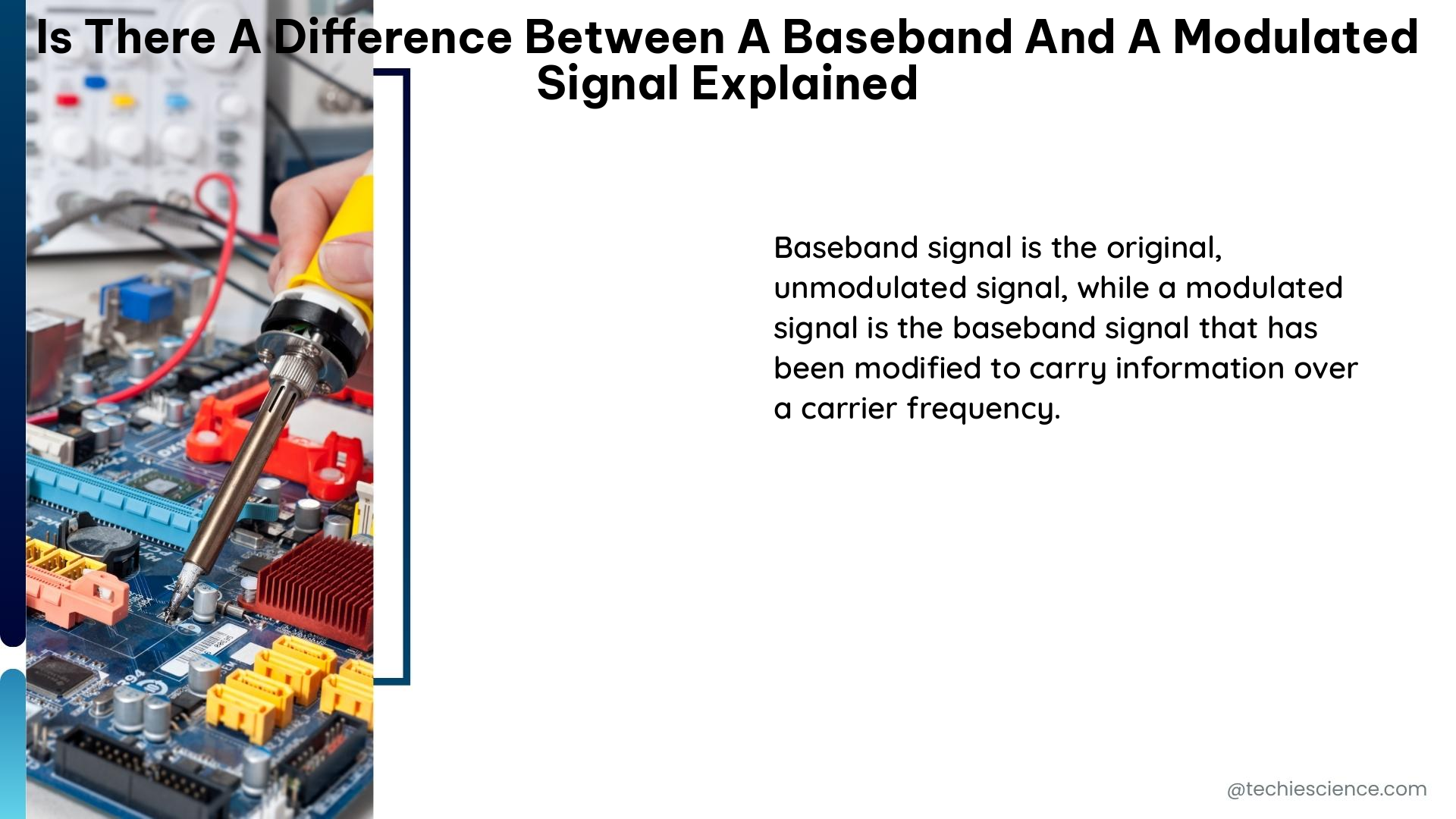In the world of communication systems, the concepts of baseband and modulated signals are fundamental. Understanding the differences between these two signal types is crucial for designing and implementing efficient communication networks. This comprehensive guide will delve into the technical details, advantages, and applications of baseband and modulated signals, providing you with a deep understanding of this crucial topic.
Baseband Signals: The Fundamental Data Transmission
Baseband signals are the most basic form of data transmission, representing the original information-bearing signal without any frequency conversion or modulation. These signals have a frequency spectrum that starts close to DC (direct current) and extends up to a specific frequency range, typically up to 1 MHz.
Baseband signals are commonly used in wired communication systems, such as Ethernet, HDMI, and USB, where the transmission distances are relatively short. The simplicity and cost-effectiveness of baseband signals make them an attractive choice for these applications.
Technical Specifications of Baseband Signals
- Frequency Range: Baseband signals have a frequency range up to 1 MHz, with the spectrum starting close to DC.
- Bandwidth: The bandwidth of a baseband signal is determined by the information content and the data rate of the transmitted data.
- Transmission Distance: Baseband signals are suitable for short to medium-distance transmission, typically within a few hundred meters.
- Modulation Techniques: Baseband signals do not require any modulation techniques, as they are the original data signals.
- Advantages: Baseband signals are simple, cost-effective, and well-suited for short-range communication scenarios.
Modulated Signals: Enabling Long-Distance Communication

Modulated signals, on the other hand, are the result of mixing the baseband signal with a higher-frequency carrier signal. This process involves changing the amplitude, frequency, and/or phase of the carrier signal proportionally to the information-bearing baseband signal. The resulting modulated signal can then be transmitted over long distances, taking advantage of the higher frequencies.
Modulated signals are commonly used in long-distance communication systems, such as long-haul telecommunications, satellite communications, and radio broadcasting. The higher frequencies and increased bandwidth of modulated signals allow for greater data transmission capacity and improved signal propagation over long distances.
Technical Specifications of Modulated Signals
- Frequency Range: Modulated signals operate at frequencies within the RF (radio frequency) range, typically higher than 1 MHz.
- Bandwidth: The bandwidth of a modulated signal is the sum of the bandwidth of the baseband signal and the bandwidth of the carrier signal.
- Transmission Distance: Modulated signals are well-suited for long-distance communication, as they can propagate over larger distances compared to baseband signals.
- Modulation Techniques: Modulated signals are created using various modulation techniques, such as amplitude modulation (AM), frequency modulation (FM), and phase modulation (PM).
- Advantages: Modulated signals offer greater capacity, higher speeds, and improved signal propagation, making them ideal for long-distance communication applications.
The Relationship Between Baseband and Modulated Signals
The relationship between baseband and modulated signals can be expressed through the following theorem:
Theorem: The total bandwidth of a modulated signal is the sum of the bandwidth of the baseband signal and the bandwidth of the carrier signal.
Proof:
1. The bandwidth of a baseband signal is given by B_b.
2. The bandwidth of the carrier signal is given by B_c.
3. When the baseband signal is modulated onto the carrier signal, the resulting modulated signal has a spectrum that is the convolution of the baseband signal spectrum and the carrier signal spectrum.
4. The convolution of two signals results in a signal with a bandwidth that is the sum of the bandwidths of the two original signals.
5. Therefore, the total bandwidth of the modulated signal is B_b + B_c.
Example:
Consider a baseband signal with a bandwidth of 100 kHz and a carrier signal with a bandwidth of 1 MHz. When the baseband signal is modulated onto the carrier signal, the resulting modulated signal has a bandwidth of 1.1 MHz.
Numerical Problem:
A baseband signal has a bandwidth of 500 kHz. The carrier signal has a bandwidth of 2 MHz. What is the total bandwidth of the modulated signal?
Solution:
The total bandwidth of the modulated signal is 2.5 MHz.
Figures and Illustrations
To better visualize the differences between baseband and modulated signals, let’s consider the following figures:
[Figure 1: Baseband Signal Spectrum]
[Figure 2: Carrier Signal Spectrum]
[Figure 3: Modulated Signal Spectrum]
These figures illustrate the frequency spectra of the baseband signal, the carrier signal, and the resulting modulated signal, respectively. The key takeaway is that the total bandwidth of the modulated signal is the sum of the bandwidths of the baseband signal and the carrier signal.
Conclusion
In summary, the primary difference between baseband and modulated signals lies in their frequency ranges and the methods used to transmit them. Baseband signals are the original data signals, suitable for short-range communication, while modulated signals are the result of mixing the baseband signal with a higher-frequency carrier signal, enabling long-distance communication.
Understanding the technical specifications, advantages, and the relationship between these two signal types is crucial for designing and implementing efficient communication systems. By mastering the concepts presented in this guide, you will be well-equipped to navigate the world of baseband and modulated signals, paving the way for your success in the field of electronics and communication engineering.
References
- Reddit Discussion on Baseband Signals
- Understanding the Differences Between Baseband and RF Modulation
- Baseband Signal on ScienceDirect
- Baseband vs. Passband Modulation on DSP Stack Exchange
- Why is Complex Baseband Better Than Real Representation on DSP Stack Exchange

The lambdageeks.com Core SME Team is a group of experienced subject matter experts from diverse scientific and technical fields including Physics, Chemistry, Technology,Electronics & Electrical Engineering, Automotive, Mechanical Engineering. Our team collaborates to create high-quality, well-researched articles on a wide range of science and technology topics for the lambdageeks.com website.
All Our Senior SME are having more than 7 Years of experience in the respective fields . They are either Working Industry Professionals or assocaited With different Universities. Refer Our Authors Page to get to know About our Core SMEs.